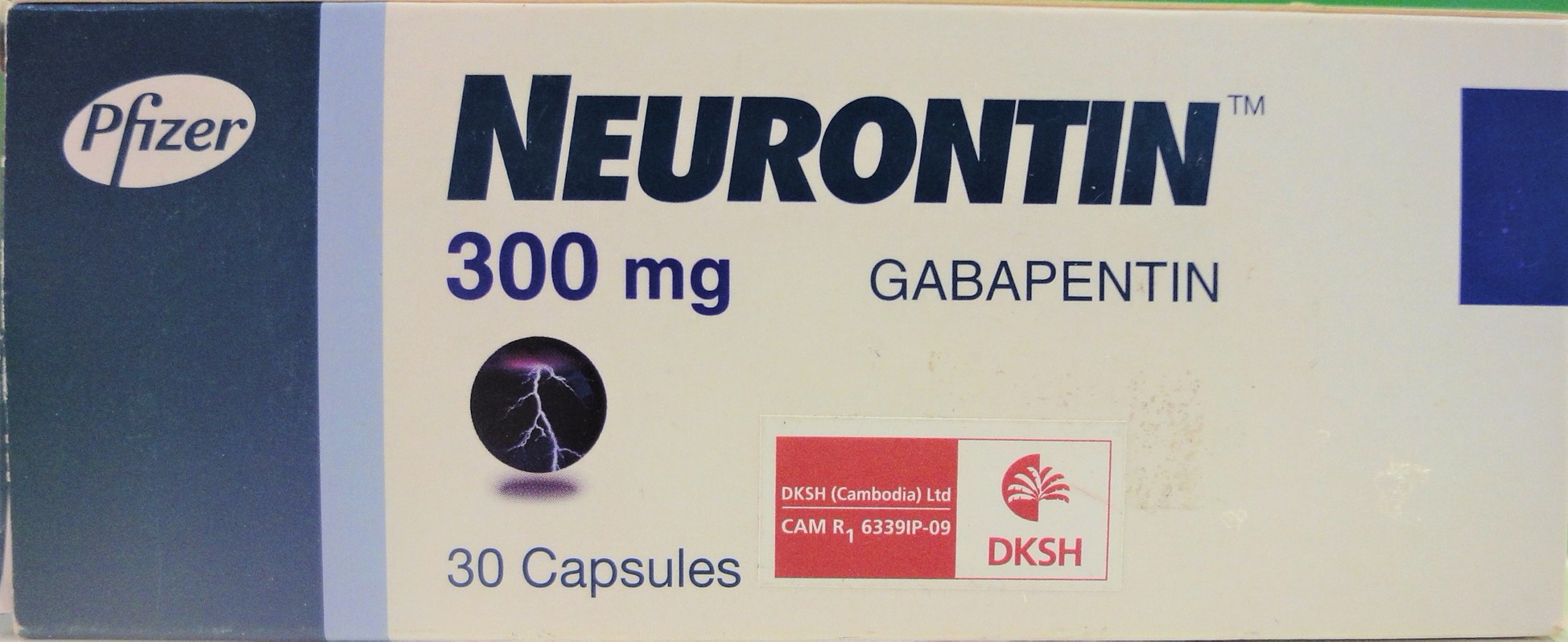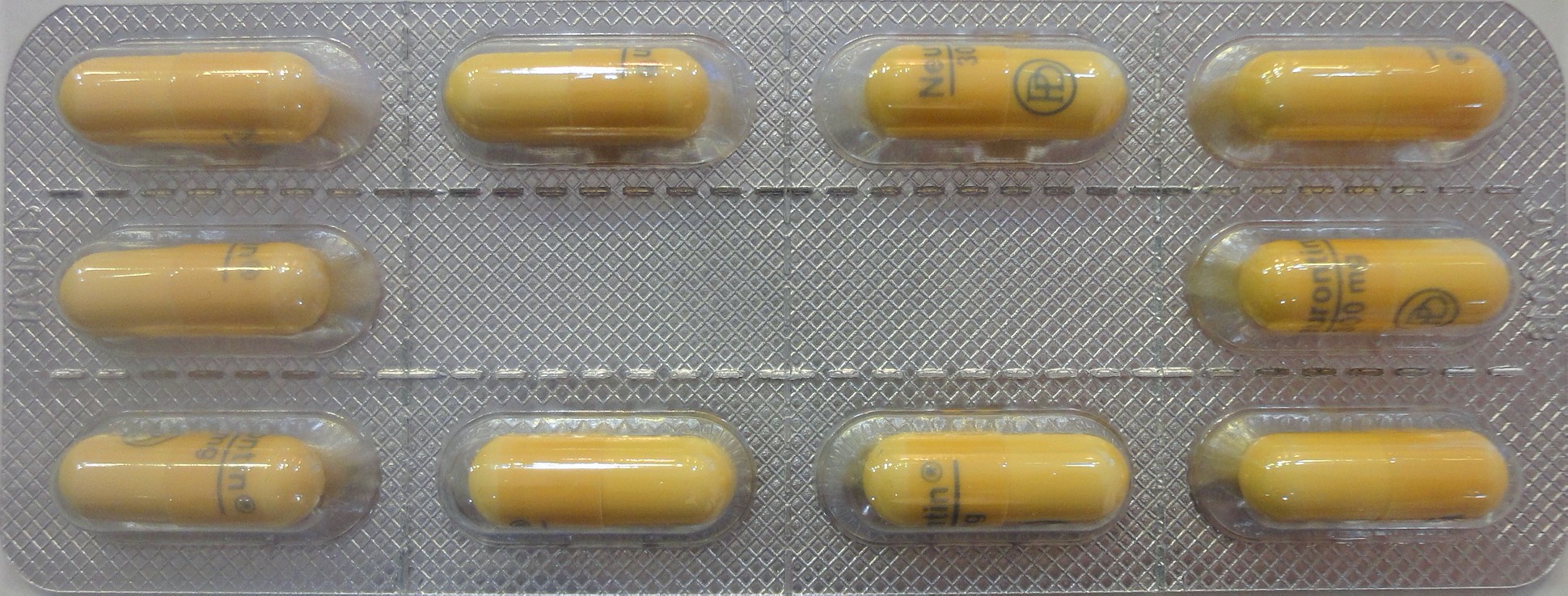NEURONTIN Capsule
ក្រុមហ៊ុនផលិតឱសថ:
Pfizer Pharmaceuticals LLC., Puerto Rico
ក្រុមហ៊ុនចែកចាយឱសថនៅប្រទេសកម្ពុជា:
DKSH


- សារធាតុសកម្ម
- ប្រសិទ្ធិភាពព្យាបាល និង កម្រិតប្រើប្រាស់
- ហាមប្រើ
- ផលរំខាន
- អន្តរប្រតិកម្ម
- ស្ត្រីមានផ្ទៃពោះ និង ស្ត្រីបំបៅដោះកូន
- ការប្រុងប្រយ័ត្នជាពិសេស បរិយាយប័ណ្ណឱសថ
-
សារធាតុសកម្ម
Gabapentin 300mg
-
ប្រសិទ្ធិភាពព្យាបាល និង កម្រិតប្រើប្រាស់
គុណភាពព្យាបាល
・ជម្ងឺឆ្កួតជ្រូក
Gabapentin គឺប្រើសម្រាប់ព្យាបាលដោយឱសថតែមួយមុខក្នុងការព្យាបាលជំងឺប្រកាច់ដោយមានឬគ្មាន Secondary generalization លើមនុស្សពេញវ័យ និងក្មេងអាយុចាប់ពី12ឆ្នាំនិងលើស។
Gabapentin គឺប្រើសម្រាប់ព្យាបាលដោយឱសថតែមួយមុខក្នុងការព្យាបាលជំងឺប្រកាច់ដោយមានឬគ្មាន Secondary generalization លើមនុស្សពេញវ័យ និងក្មេងអាយុចាប់ពី3ឆ្នាំនិងលើស។
・ការឈឺចាប់សរសៃប្រសាទ
Gabapentin គឺប្រើសម្រាប់ព្យាបាលដោយឱសថតែមួយមុខក្នុងការព្យាបាលការឈឺចាប់សរសៃប្រសាទលើមនុស្សពេញវ័យអាយុ18ឆ្នាំនិងលើស។
កម្រិតនិងរបៀបប្រើ
- ជាទូទៅ
Gabapentin លេបពេលបាយ ឬពោះទទេ។ ទៅតាមការយល់ឃើញរបស់គ្រូពេទ្យ មានតម្រូវការបន្ថយកម្រិតប្រើ ការបញ្ឈប់ប្រើ ឬការប្រើជំនួសដោយឱសថផ្សេង ត្រូវធ្វើឡើងបន្តិចម្ដងៗរយៈពេលយ៉ាងតិច1សប្ដាហ៍។
・ជំងឺឆ្កួតជ្រូក
- មនុស្សពេញវ័យ និងកុមារអាយុចាប់ពី12ឆ្នាំទៅ
កម្រិតប្រើពេលព្យាបាលដោយលេបម្ដង 300ម.ក្រ 3ដងក្នុង1ថ្ងៃ នៅថ្ងៃទី1 បន្ទាប់មក កម្រិតប្រើអាចបង្កើនដល់អតិបរមា 3600 ម.ក្រ ដោយចែកជា3ដង/1ថ្ងៃ។
ថ្ងៃទី1 300ម.ក្រ 1ដង/ថ្ងៃ។ ថ្ងៃទី2 300ម.ក្រ 2ដង/ថ្ងៃ។ ថ្ងៃទី3 300ម.ក្រ 3ដង/ថ្ងៃ។
- អ្នកជំងឺកុមារអាយុ 3-12ឆ្នាំ
កម្រិតប្រើ 10-15ម.ក្រ/ថ្ងៃ ដោយចែកជាបីដងក្នុង1ថ្ងៃ។ កម្រិតប្រើដែលមានប្រសិទ្ធភាពចំពោះអ្នកជំងឺកុមារអាយុ5ឆ្នាំ និងលើសគឺ 25-35ម.ក្រ/គ.ក្រ/ថ្ងៃ ដោយចែកជាបីដងក្នុង1ថ្ងៃ។ កម្រិតប្រើដែលមានប្រសិទ្ធភាពចំពោះអ្នកជំងឺកុមារអាយុ3ឆ្នាំរហូតដល់តិចជាង5ឆ្នាំគឺ 40ម.ក្រ/គ.ក្រ/ថ្ងៃ ដោយចែកជាបីដងក្នុង1ថ្ងៃ។ កម្រិតប្រើរហូតដល់ 50ម.ក្រ/គ.ក្រ/ថ្ងៃ មានការអនុគ្រោះល្អក្នុងការសិក្សាគ្លីនិក។
・ការឈឺចាប់សរសៃប្រសាទ
កម្រិតដំបូង 900ម.ក្រ/1ថ្ងៃដោយបែងចែកកំរិតស្មើៗគ្នា (3ដង/1ថ្ងៃ) អាចបង្កើនកម្រិតប្រសិនបើចាំបាច់ដោយផ្អែកលើការឆ្លើយតបនឹងការព្យាបាល កម្រិតប្រើខ្ពស់រហូតដល់ 3600ម.ក្រ/1ថ្ងៃ។
・កម្រិតប្រើ Gabapentin លើមនុស្សពេញវ័យដោយផ្អែកលើមុខងារតំរងនោម
- Creatinine Clearance (ml/min) ≧80 កម្រិតប្រើ/1ថ្ងៃ (ម.ក្រ/1ថ្ងៃ) 900 ទៅ 3600
- Creatinine Clearance (ml/min) 50-79 កម្រិតប្រើ/1ថ្ងៃ (ម.ក្រ/1ថ្ងៃ) 600 ទៅ 1800
- Creatinine Clearance (ml/min) 30-49 កម្រិតប្រើ/1ថ្ងៃ (ម.ក្រ/1ថ្ងៃ) 300 ទៅ 900
- Creatinine Clearance (ml/min) 15-29 កម្រិតប្រើ/1ថ្ងៃ (ម.ក្រ/1ថ្ងៃ) 150 ទៅ 600
- Creatinine Clearance (ml/min) <15 កម្រិតប្រើ/1ថ្ងៃ (ម.ក្រ/1ថ្ងៃ) 150 ទៅ 300
・ការកែតម្រូវកំរិតប្រើលើអ្នកជំងឺកំពុងលាងឈាម
ចំពោះអ្នកជំងឺកំពុងលាងឈាមមិនដែលប្រើ Gabapentin ពីមុនមក កម្រិតប្រើសម្រុកគឺ 300ម.ក្រទៅ400ម.ក្រ បន្ទាប់មកប្រើ Gabapentin 200ម.ក្រទៅ300ម.ក្រ រយៈ4ម៉ោងក្រោយពីការលាងឈាមម្ដងៗ។~Therapeutic indications Epilepsy
Gabapentin is indicated as monotherapy in the treatment of partial seizures with and without secondary generalization in adults and children aged 12 years and older.
Gabapentin is indicated as adjunctive therapy in the treatment of partial seizures with and without secondary generalization in adults and children aged 3 years and older.
Neuropathic pain
Gabapentin is indicated for the treatment of neuropathic pain in adults aged 18 years and older.
Posology and method of administration:
Gabapentin is given orally with or without food.
When, in the judgment of the clinician, there is a need for dose reduction, discontinuation, or substitution with an alternative medication, this should be done gradually over a minimum of 1 week.
Epilepsy
Adults and pediatric patients older than 12 years of age
In clinical trials, the effective dosing range was 900 mg/day to 3600 mg/day. Therapy may be initiated by administering 300mg three times a day on Day 1 or by titrating the dose. Thereafter, the dose can be increased in three equally divided doses up to a maximum dose of 3600/day. Doses up to 4800mg/day have been well tolerated in long-term open-label clinical studies. The maximum time between doses in the three times a day schedule should not exceed 12 hours to prevent breakthrough convulsions.
Day 1: 300mg once a day, day 2: 300mg two times a day, day 3: 300mg three times a day.
Pediatric patients aged 3 to 12 years
The strating dose should range from 10 to 15mg/kg/day given in equally divided doses (three times a day) and the effective dose reached by upward titration over a period of approximately 3 days. The effective dose of gabapentin in pediatric patients aged 5 years and older is 25 to 35 mg/kg/day given in equally divided doses (three times a day). The effective dose in pediatric patients aged 3 to less than 5 years is 40 mg/kg/day given in equally divided doses (three times a day). Doses up to 50mg/kg/day have been well tolerated in a long-term clinical study. The maximum time interval between doses should not exceed 12 hours.
Neuropathic pain in adults
The starting dose is 900 mg/day given in three equally divided doses, and increased if necessary, based on response, up to a maximum dose of 3600 mg/day.
Dose adjustment in impaired renal function in patients with neuropathic pain or epilepsy
Dose adjustment is recommended in patients with compromised renal function (Table 2) and/or in those undergoing hemodialysis.
- Creatinine Clearance (ml/min) ≧80 total daily doses (*) (mg/day) 900 to 3600
- Creatinine Clearance (ml/min) 50-79 total daily doses (*) (mg/day) 600 to 1800
- Creatinine Clearance (ml/min) 30-49 total daily doses (*) (mg/day) 300 to 900
- Creatinine Clearance (ml/min) 15-29 total daily doses (*) (mg/day) 150 (**) to 600
- Creatinine Clearance (ml/min) <15 total daily doses (*) (mg/day) 150 (**) to 300(*) Total dally dose should be administered as a three times a day regimen. Doses used to treat patients with normal renal function (creatinine clearance ≥80 ml/min) range from 900 mg/day to 3600 mg/day. Reduced dosages are for patients with renal impairment (creatinine clearance <79 ml/min).
(**) To be administered as 300 mg every other day.
Dose adjustment in patients undergoing hemodialysis
For patients undergoing hemodialysis who have never received gabapentin, a loading dose of 300 mg to 400 mg is recommended, and then 200 mg to 300 mg of gabapentin following each 4 hours of hemodialysis.
-
ហាមប្រើ
ហាមប្រើចំពោះអ្នកងាយប្រតិកម្មជាមួយ Gabapentin ឬសារធាតុផ្សំណាមួយនៃឱសថនេះ។
Gabapentin is contraindicated in patients who are hypersensitive to gabapentin or the product’s components.
-
ផលរំខាន
ផលរំខានខ្លះៗ៖
- រាងកាយទាំងមូល៖ ឈឺពោះ ឈឺខ្នង អស់កំលាំង គ្រុន ឈឺក្បាល ការឆ្លងវីរុស
- សរសៃឈាមបេះដូង៖ រីកសរសៃឈាម
- ប្រព័ន្ធរំលាយអាហារ៖ ទល់លាមក ធ្មេញខុសធម្មតា រាក ពិបាករំលាយអាហារ ឃ្លានអាហារ ស្ងួតមាត់ ឬស្ងួតបំពង់ក ក្អួតឬចង្អោរ។
- ប្រព័ន្ធឈាមនិងទឹករងៃ៖ ចំនួនគ្រាប់ឈាមសថយចុះ ការរាប់ចំនួនកោសិកាឈាមសថយចុះ។
- មេតាបូលីស និងជីវជាតិ៖ ហើមដៃជើង កើនទំងន់។
- ប្រព័ន្ធសាច់ដុំជាប់ឆ្អឹង៖ ការបាក់ឆ្អឹង ឈឺសាច់ដុំ
- ប្រព័ន្ធប្រសាទ៖ បាត់បង់ការចងចាំ យឺតសរសៃ ភាន់ភាំង សាច់ដុំធ្វើចលនាខុសធម្មតា បាក់ទឹកចិត្ត ធេងធោង ពិបាកក្នុងការនិយាយច្បាស់ អារម្មណ៍មិននឹងន អត់ងងុយដេក មួរម៉ៅ កន្ត្រាក់គ្រាប់ភ្នែក ងងុយដេក ការគិតខុសធម្មតា ញ័ខ្លួន ញាក់។
- ប្រព័ន្ធដង្ហើម៖ ក្អក រលាកបំពង់ក រលាកច្រមុះ។
- ស្បែក និងជាលិកាជុំវិញស្បែក៖ សឹកស្បែក កើតមុន រមាស់ កន្ទួលក្រហម
- វិញ្ញាណពិសេស៖ ងងឹតបន្តិចម្ដងៗ ការមើលឃើញរូបពីរ។
- ប្រព័ន្ធបោម-ប្រដាប់ភេទ៖ អសមត្ថភាពផ្លូវភេទ។Body as a Whole: asthenia; malaise; facial edema Cardiovascular System: hypertension Digestive System: flatulence; anorexia; gingivitis
Hematologic and Lymphatic Systems: purpura; most often described as bruises resulting from physical trauma Musculoskeletal System: arthralgia
Nervous System: vertigo; hyperkinesia; increased, decreased, or absent reflexes; paresthesia; anxiety; hostility Respiratory System: pneumonia Urogenital System: urinary tract infection
Special Senses: abnormal vision; most often described as a visual disturbance
In children aged 3 to 12 years, were viral infection, fever, nausea and/or vomiting, and somnolence.
In all clinical studies, the most frequently occurring events that contributed to discontinuation of gabapentin included somnolence, ataxia, dizziness, fatigue, and nausea and/or vomiting.
The adverse events most commonly associated with withdrawal were dizziness, nervousness, weight gain, nausea and/or vomiting, and somnolence.
The adverse events most commonly associated with withdrawal in children were somnolence, hyperkinesia, and hostility.
Additional post-marketing adverse events reported include blood creatine phosphokinase increased, rhabdomyolysis, acute kidney failure, allergic reaction including urticaria, alopecia, anaphylaxis, angioedema, hyperglycemia and hypoglycemia (most often observed in patients with diabetes), breast hypertrophy, chest pain, drug rash with eosinophilia and systemic symptoms, elevated liver function tests (LFTs), erythema multiforme, fall, generalized edema, gynecomastia, hallucinations, hepatitis, hypersensitivity including systemic reactions, hyponatremia, jaundice, loss of consciousness, movement disorders, such as choreoathetosis, dyskinesia, and dystonia, myoclonus, palpitation, pancreatitis, sexual dysfunction (including changes in libido, ejaculation disorders and anorgasmia), Stevens-Johnson syndrome, thrombocytopenia, tinnitus, and urinary incontinence.
Adverse events following the abrupt discontinuation of gabapentin have also been reported. The most frequently reported events were anxiety, insomnia, nausea, pain, and sweating.
-
អន្តរប្រតិកម្ម
អន្តរកម្មឱសថ៖
- គ្មានអន្តរកម្មរវាង Gabapentin ជាមួយ phenobarbital, phenytoin, valproic acid or carbamazepine ត្រូវបានសង្កេតឃើញទេ។
- ការប្រើដំណាលគ្នា Gabapentin ជាមួយឱសថពន្យារកំណើតគ្រាប់ ដែលមាន norethindrone and/or ethinyl estradiol មិនជះឥទ្ធិពលដល់ pharmacokinetics របស់សារធាតុវាទេ។
- ការប្រើដំណាលគ្នា Gabapentin ជាមួយឱសថ antacid ដែលមាន aluminium and magnesium បន្ថយអត្រាក្នុងឈាមរបស់ Gabapentin ប្រហែល 20%។ ជាការណែនាំ ត្រូវលេប Gabapentin 2ម៉ោង បន្ទាប់ពីប្រើឱសថantacid។
- ការថយចុះតិចតួចនូវការបញ្ចេញ Gabapentin មកក្រៅខ្លួនតាមទឹកនោមដែលគេសង្កេតឃើញពេលប្រើដំណាលគ្នាជាមួយ cimetidine គឺមិនមានលក្ខណៈផ្នែកគ្លីនិកទេ។Morphine
In a study involving healthy volunteers (N=12), when a 60-mg controlled-release morphine capsule was administered 2 hours prior to a 600-mg gabapentin capsule, mean gabapentin AUC increased by 44% compared to gabapentin administered without morphine. This was associated with an increased pain threshold (cold pressor test). The clinical significance of such changes has not been defined. Morphine pharmacokinetic parameter values were not affected by administration of gabapentin 2 hours after morphine. The observed opioid-mediated side effects associated with morphine plus gabapentin did not differ significantly from morphine plus placebo.
No interaction between gabapentin and phenobarbital, phenytoin, valproic acid, or carbamazepine has been observed. Gabapentin steady-state pharmacokinetics are similar for healthy subjects and patients with epilepsy receiving these antiepileptic agents. Co-administration of gabapentin with oral contraceptives containing norethindrone and/or ethinyl estradiol does not influence the steady-state pharmacokinetics of either component.
Co-administration of gabapentin with antacids containing aluminum and magnesium reduces gabapentin bioavailability by about 20%. It is recommended that gabapentin be taken about 2 hours following antacid administration.
Renal excretion of gabapentin is unaltered by probenecid.
A slight decrease in renal excretion of gabapentin that is observed when it is co-administered with cimetidine is not expected to be of clinical importance.
-
ស្ត្រីមានផ្ទៃពោះ និង ស្ត្រីបំបៅដោះកូន
・ស្ត្រីមានផ្ទៃពោះ៖ ដោយសារគ្មានទិន្នន័យគ្រប់គ្រាន់អំពីការប្រើឱសថនេះលើស្ត្រីមានផ្ទៃពោះ។ ដោយសារការសិក្សាលើសត្វមិនអាចព្យាករណ៍បានជានិច្ចលើមនុស្ស ឱសថនេះអាចប្រើបានពេលមានផ្ទៃពោះ នៅពេលណាដែលផលចំណេញមានច្រើនលើសផលរំខានដល់គភ៌។
・ស្ត្រីបំបៅដោះកូន Gabapentin ជ្រាបចូលក្នុងទឹកដោះម្ដាយ។ ដោយសារឥទ្ធិពលលើទារកបៅដោះមិនដឹងគួរប្រុងប្រយ័ត្នប្រើ Gabapentinទៅលើស្ត្រីបំបៅដោះកូន។ Gabapentin អាចប្រើបានលើស្ត្រីបំបៅដោះកូន បើសិនផលចំណេញមានច្រើនជាងហានិភ័យតែប៉ុណ្ណោះ។Pregnancy
There are no adequate and well-controlled studies in pregnant women. Because animal reproduction studies are not always predictive of human response, this drug should be used during pregnancy only if the potential benefit to the patient justifies the potential risk to the fetus
Lactation
Gabapentin is excreted in human milk. Because the effect on the nursing infant is unknown, caution should be exercised when gabapentin is administered to a nursing mother.
Gabapentin should be used in nursing mothers only if the benefits clearly outweigh the risks.
-
ការប្រុងប្រយ័ត្នជាពិសេស
ការប្រុងប្រយ័ត្ន
ទោះបីជាគ្មានភស្តុតាងការប្រកាច់កើតឡើងវិញដោយសារការប្រើ Gabapentin ការឈប់ប្រើឱសថព្យាបាលភ្លាមៗចំពោះអ្នកជំងឺឆ្កួតជ្រូក អាចបណ្ដាលអោយប្រកាច់។
ការព្យាបាលដោយ Gabapentin ជាប់ទាក់ទងនឹងអាការៈធេងធោង និងងងុយដេកដេលអាចបណ្ដាលអោយដួល មនាការកើនឡើង។ មានការរាយការណ៍ឱសថដាក់លក់លើទីផ្សារអំពីការភាន់ភាំង បាត់ស្មារតី ការចងចាំថយចុះ។ ដូច្នេះ អ្នកជំងឺត្រូវចងចាំរហូតដល់ពួកគេស្គាល់ឥទ្ធិពលរបស់ឱសថនេះ។
ចំពោះអ្នកជំងឺដែលតម្រូវអោយប្រើដំណាលគ្នាជាមួយឱសថ Opioids អាចជួបប្រទះការកើនឡើងកំហាប់ Gabapentin។ អ្នកជំងឺត្រូវសង្កេតដោយប្រុងប្រយ័ត្នអំពីរោគសញ្ញាការថយចុះកំលាំងចលកប្រព័ន្ធសរសៃប្រសាទកណ្ដាល ដូចជា ងងុយដេក និងការថយចុះកំលាំងចលកដកដង្ហើម។ ត្រូវបន្ថយកំរិតប្រើ Gabapentin ឬ Opioids។General
Although there is no evidence of rebound seizures with gabapentin, abrupt withdrawal of anticonvulsants in epileptic patients may precipitate status epileptics.
Gabapentin is generally not considered effective in the treatment of absence seizures.
Gabapentin treatment has been associated with dizziness and somnolence, which could increase the occurrence of accidental injury (fall). There have also been post-marketing reports of confusion, loss of consciousness and mental impairment. Therefore, patients should be advised to exercise caution until they are familiar with the potential effects of the medication.
Patients who require concomitant treatment with opioids may experience increases in gabapentin concentrations. Patients should be carefully observed for signs of central nervous system (CNS) depression, such as somnolence, sedation and respiratory depression and the dose of gabapentin or opioid should be reduced appropriately.
Drug rash with eosinophilia and systemic symptoms
Severe, life-threatening, systemic hypersensitivity reactions such as drug rash with eosinophilia and systemic symptoms (DRESS) have been reported in patients taking antiepileptic drugs, including gabapentin.
It is important to note that early manifestations of hypersensitivity, such as fever or lymphadenopathy, may be present even though rash is not evident. If such signs or symptoms are present, the patient should be evaluated immediately. Gabapentin should be discontinued if an alternative etiology for the signs or symptoms cannot be established.
Anaphylaxis
Gabapentin can cause anaphylaxis. Signs and symptoms in reported cases have included difficulty breathing, swelling of the lips, throat, and tongue, and hypotension requiring emergency treatment. Patients should be instructed to discontinue gabapentin and seek immediate medical care should they experience signs or symptoms of anaphylaxis.
Abuse ad Dependence
Cases abuse and dependence have been reported in the post-marketing database. As with any CNS active drug, carefully evaluate patients for a history of drug abuse and observe them for possible signs of gabapentin abuse.
Information for patients
To assure safe and effective use of gabapentin, the following information and instructions should be given to patients: (See the insert package about details.)
*ព័ត៌មានឱសថត្រូវបានរៀបរៀងដោយ អ៊ីម៉ាតុគឹ មេឌីក (ខេមបូឌា) ដោយផ្អែកលើប្រភពព័ត៌មានខាងក្រោម។ សម្រាប់ព័ត៌មានលម្អិត សូមស្វែងរកនៅក្នុងក្រដាសព័ត៌មាននៃឱសថនីមួយៗ ឬ សាកសួរទៅកាន់ក្រុមហ៊ុនឱសថឬតំណាងចែកចាយនៃឱសថនីមួយៗ។
ប្រភពព័ត៌មាន៖
- ក្រដាសព័ត៌មាននៃឱសថសម្រាប់អ្នកជំនាញវេជ្ជសាស្ត្រដែលប្រើប្រាស់នៅប្រទេសជប៉ុន (Pharmaceutical and Medical Devices Agency, Pmda): https://www.pmda.go.jp
- ព័ត៌មានសង្ខេបនៃឱសថសម្រាប់អ្នកជំងឺដែលប្រើប្រាស់នៅប្រទេសជប៉ុន: http://www.rad-ar.or.jp
